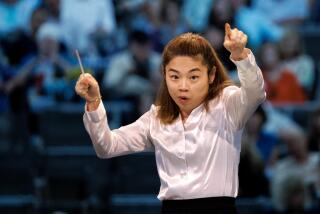Song for a trombone
Berlioz once claimed that trombones have the power to not only mourn but also raise the dead. He likened trombones to a choir of priests who could call us to quiet prayer, but he also used the instrument as a call to orgy.
A trombone can, in other words, be both an epic and ribald voice in the orchestra, sometimes stern orator, occasionally clown. Indeed, Viennese composer Kurt Schwertsik has titled a new whimsical trombone concerto âMixed Feelings.â A recent trombone concerto by Luciano Berio is vivid theater. Christopher Rouseâs Trombone Concerto, which won the Pulitzer Prize 10 years ago, is darkly, profoundly elegiac.
In âCanticle Weaving,â the concerto for trombone commissioned by the Los Angeles Philharmonic from Augusta Read Thomas, the trombone maintains a noble bearing but is not afraid to swing. In listening to its premiere, conducted by Esa-Pekka Salonen at the Dorothy Chandler Pavilion on Saturday night, I heard in the solo line the commanding voice of an uncommon leader -- astute, steadfast, courtly and a good dancer. Kofi Annan came to mind.
The concerto was written for the Philharmonicâs principal trombonist Ralph Sauer, who has been with the orchestra nearly 30 years but only once before played a concerto with it (by Kazimierz Serocki) in 1979. The collaboration between Thomas and Sauer, who did not know each other, was by e-mail between L.A. and Chicago, where Thomas, a former composer-in-residence for the Chicago Symphony, teaches.
The trombonist asked for something of sustained lyrical nature throughout and also expressed his dislike of mutes. The composer added to the mix her own disinterest in the jocular nature of the trombone. In particular, she wanted to avoid one of the instrumentâs most characteristic effects, the glissando.
âCanticle Weavingâ begins with a sweeping rhetorical melody for the trombone that contains a couple of racy touches in its flicker of shimmying rhythm and suggestive grace notes. The orchestra through this first part, titled âStar Song,â teases and entices the aristocratic soloist. Thomas, an enthusiastic composer born in 1964, has quick compositional responses. Every minute or two, she hits an orchestral refresh button, placing the soloist in a new environment. The winds might chirp excitedly upon hearing a three-note phrase from the trombone, whereas the strings might respond to the soloist with ghostly nature sounds.
Nothing lasts very long, and the score is animated with exhortations for the players to be âblazing and passionateâ or âspunky and intenseâ or ârhapsodic and lyrical.â Thomas constantly asks them to speed up or slow down. But nothing comes out of nowhere; the orchestra regularly takes off from something heard in the trombone. And through it all, the trombone rises to these fleeting emotions without ever losing its dignity.
Though this is the first piece by Thomas the full orchestra has performed, it was evidently written to both Sauerâs and Salonenâs strengths, and the performance was outstanding. Sauer maintained the unceasingly eloquent lyricism, while Salonen encouraged a frisky virtuosity from the Philharmonic.
Just back from a New York tour, the Philharmonic sounded in excellent form all evening. Straussâ early Serenade for 13 winds opened the program with seamless, glowing playing. And at the end, Brahmsâ Double Concerto, featuring violinist Bing Wang and cellist Ben Hong as soloists, proved boldly compelling.
Late Brahms, the Double Concerto is often thought of as an autumnal piece. It can foster a kind of competition between soloists, who vie to outdo each other with rhapsodic intensity. But the noticeably pregnant Wang as well as Hong, young members of the Philharmonic string section -- she is associate concertmaster; he, assistant principal cellist -- sounded as though they were born to play together as they attacked their parts with a single-minded ferocious energy.
With Salonen leading an unusually taut, muscular, rhythmically driven performance, suddenly the Double Concerto seemed as fresh as the youthful Strauss and as new as the Thomas concerto. There are bound to be listeners who hate their Brahms served this aggressively, just as there are surely some who canât imagine a trombone not merrily or seductively sliding all over the place. But the orchestra enjoys a reputation for presenting classical music as a living, unpredictable, meaningful art form, and that does not mean business as usual.
More to Read
The biggest entertainment stories
Get our big stories about Hollywood, film, television, music, arts, culture and more right in your inbox as soon as they publish.
You may occasionally receive promotional content from the Los Angeles Times.











